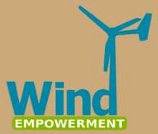| The VIRYA-1.8D,the VIRYA-3.8 and the VIRYA-4.1 windmills are designed especially for manufacture in developing countries. These three VIRYA windmills have 3-bladed rotors and are meant for 24 V battery charging except the VIRYA-4.1 which is meant for 48 V battery charging. The blades are made from galvanised steel sheet and have 7.14 % cambered airfoils. The blades are bolted to a welded hub assembly. Special tools are developed for curving the steel blades using a simple press for the VIRYA-1.8D and a jig with hydrauliccar jacks for the VIRYA-3.8 and the VIRYA-4.1. The INA Permaglide head bearings are waterproof and the mills are entirely maintenance free. The geometry and strength of the VIRYA-1.8D,the VIRYA-3.8 and the VIRYA-4.1 rotors are calculated in respectively report KD222,KD 231 and KD 303.These windmills have generators based on standard rotary current motors. These motors are modified with a permanent magnet armature with neodymium magnets and a stainless steel shaft. The windmill rotor is mounted directly to the tapered shaft of the generator. The windmill rpm range is much lower than the nominal motor rpm. Using the standard 230/400V winding, 24 V DC can be generated with delta rectification of the winding for the VIRYA-1.8D. The VIRYA-3.8 uses a 230/400 V winding with star rectification for 24V battery charging and is specially designed for regions with very low wind speeds. The VIRYA-4.1 uses a 400/690 V winding with star rectification for 48 V battery charging. The VIRYA-1.8D generator is almost identical to the VIRYA-1.8 generator with stainless steelblades. The VIRYA-3.8 makes use a motor housing size 112. The generator is identical to the VIRYA-4.2 generator but for the VIRYA-4.2 the generator is used for 48 V battery charging and the maximum power is there fore much higher. The VIRYA-4.1 generator makes use of a 4-pole,7.5 kW motor housing size 132. The generator can be used as a brake by short-circuiting the generator winding. The VIRYA-1.8D and the VIRYA-3.8 generators have been tested on a test-rig at the University of Technology Eindhoven (see reports KD54 and KD 200). The VIRYA-4.1 generator is not yet tested but tests for the generator of the former VIRYA-5A windmill, given in report KD 82 are used to determine the characteristics. The batteries are protected against over charging by a 27.6V battery charge controller with dump load. The dump load of the VIRYA-1.8D is integrated in the controller but the VIRYA-3.8 has a separate dump load. The VIRYA-4.1 has two 27.6 V battery charge controllers and two dump loads in series and can be used for 24 V and 48 V equipment.The windmills are provided with a “hinged side vane safety system”to limit rotor rpm and thrust at high wind speeds. The rotor axis is offset from the tower axis. The vane juts out along the rotor and the vane blade is connected to the vane arm using hinges. At low wind speeds, the vane blade hangs in almost vertical position and the rotor is perpendicular to the wind. At wind speeds higher than about 6 m/s the rotor starts to turn gradually out of the wind. At very high wind speeds the rotor turns out of the windby about 75° and the vane blade is in almost horizontal position. The behaviour of this system is very stable and the rotor speed is well controlled. This safety system is described and the -V curve is calculated for the VIRYA-4.1 windmill, in report KD 304.The tower of the VIRYA-1.8D consists of a 2 metre tubular upper section which can be connected to a supporting structure such as a wall of a house. If a supporting structure is not available a wooden lower tower pole can be used. The VIRYA-3.8 and the VIRYA-4.1 have an identical tower which is made of a 3 metre tubular upper tower section and a 7 metre non-guyed 4-legs lattice lower section. This lower section is divided into two parts of 3.5 m. The strength of the tower is calculated for the VIRYA-4.1 in report KD 305. Earlier types of similar windmills have been tested for many years. The VIRYA-1.8D has been tested from 2002 till 2014. The VIRYA-3.8 will not be tested by Kragten Design.A modified VIRYA-4.1 has been tested in the Philippine Islands. A prerequisite for manufacture of these windmills in developing countries is that one is able to import some of the materials and standard parts. Kragten Design cannot supply materials and parts such as bearings, generators, magnets, electronics. The required workshop skills are sawing, drilling, turning, milling and welding.
|
|
Data
|
| Size |
184.39 KB |
| Download Language |
English |
| Author |
Dit e-mailadres wordt beveiligd tegen spambots. JavaScript dient ingeschakeld te zijn om het te bekijken. |
| Website |
Website  |
|
Download
|
|



 Renewable energy world
Renewable energy world
 Watt is duurzaam
Watt is duurzaam






